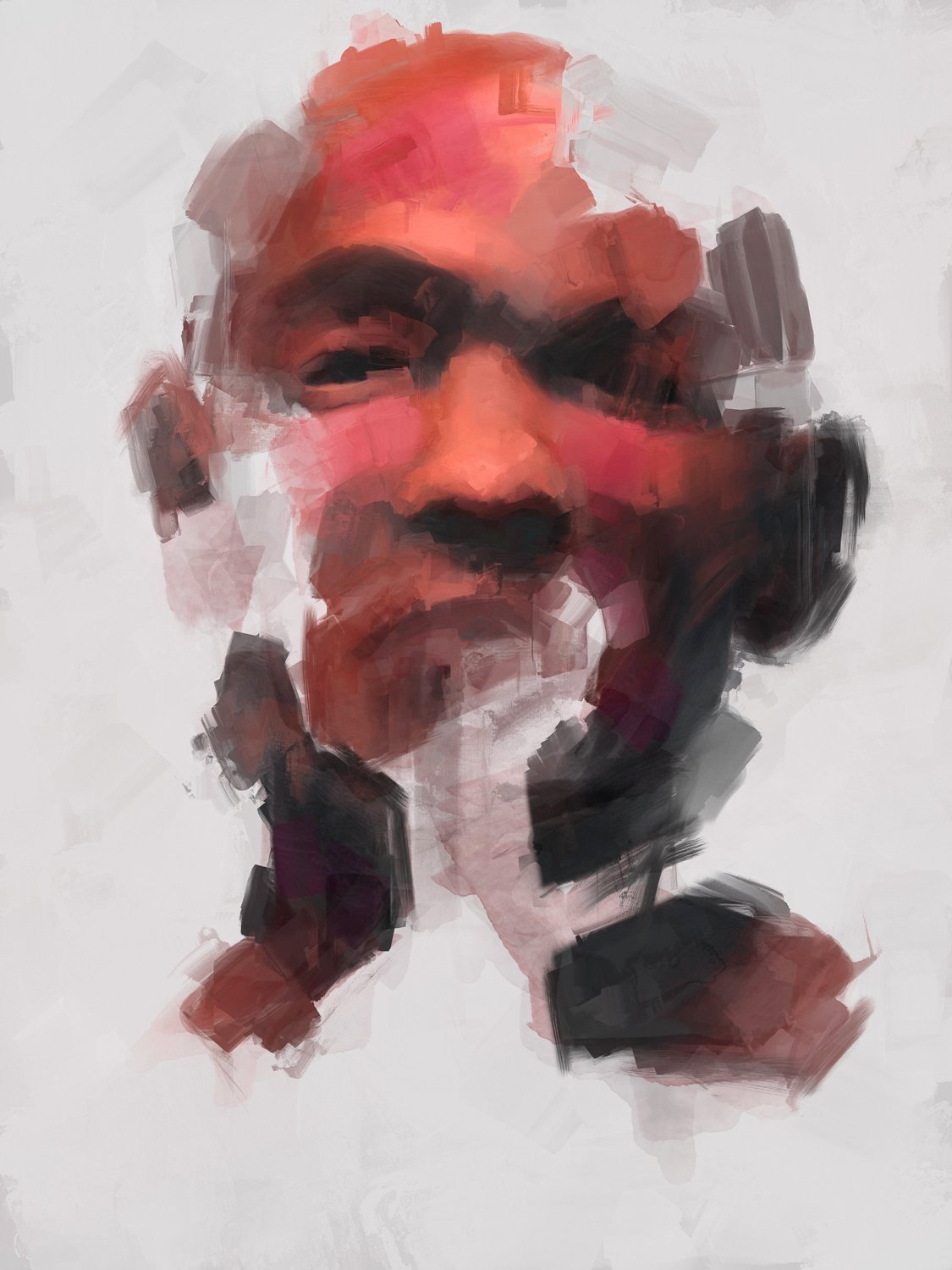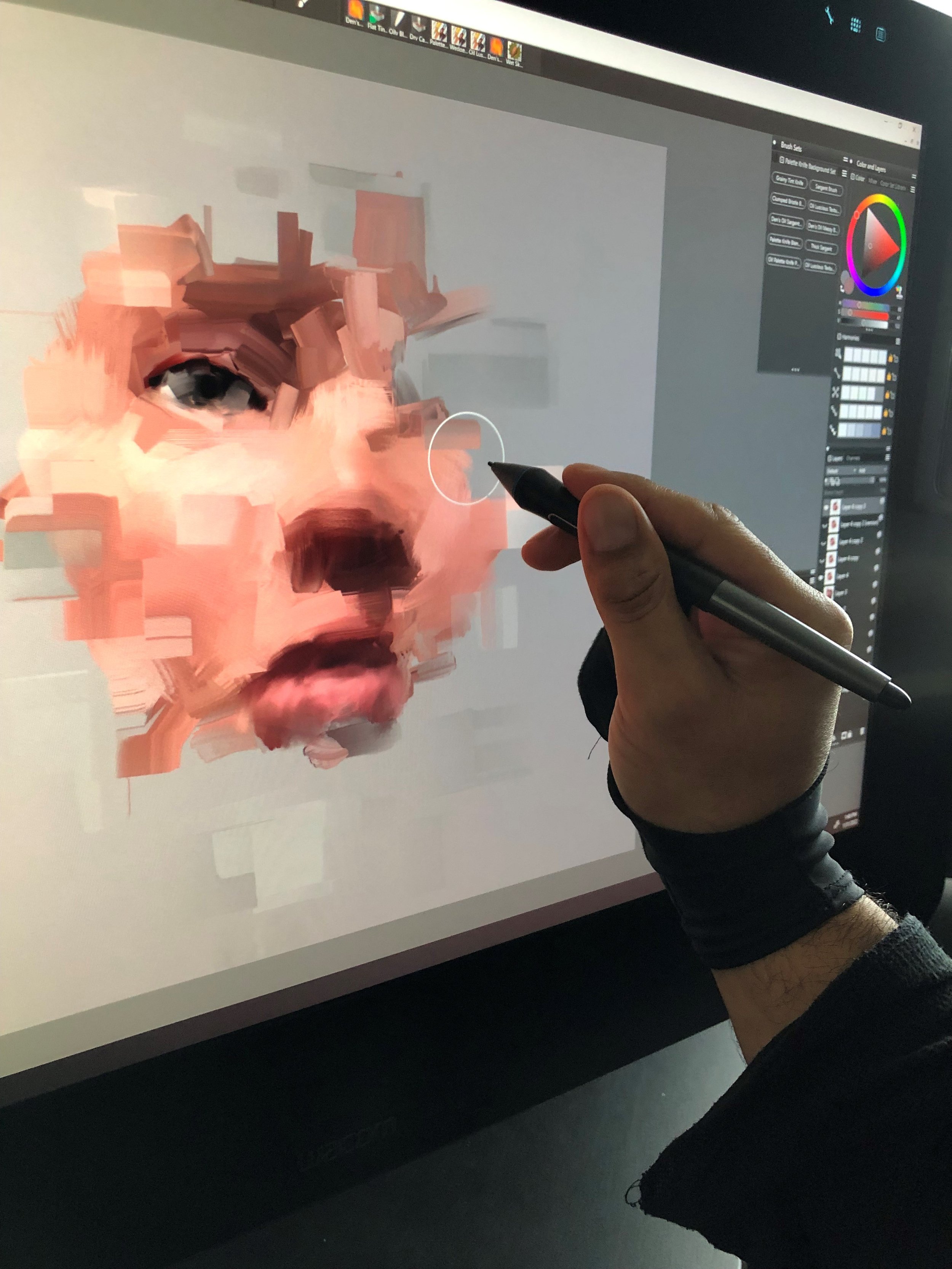Interview
Andrew Binder
Andrew Binder is a visual artist currently based in New York City, where he was born and bred. After studying art history and art, with a focus in photography, he worked for many years in the stock photography industry. During this period, he came to the realization that his need to create was not being met. He began to balance a serious pursuit of art with a full-time work schedule.
Becoming increasingly interested in the digital art space and the potential it promised, Andrew taught himself digital art techniques.
Andrew’s artwork has evolved into an expressionistic merge of largely figurative and abstracted elements that invite the viewer to have their own subjective experience and interpretation. Combining digital painting and traditional mediums, Andrew creates imagery that is concerned with process as well as evoking transitory memory, feelings and existential concerns.
His work has appeared in various exhibitions across the United States and France, as well as in numerous publications.
What is your background and how did you start your journey in the art world?
“I am a contemporary visual artist from New York City. Art has been a main interest of mine ever since I was a child. I grew up drawing all the time. As I got older, I explored painting, photography and other mediums. However, I was not been able to devote myself to becoming a full-time artist until around 2017. Despite becoming serious about pursuing art years before that, I struggled fitting it in around the conventional 9 to 5 work life. In recent years, I feel that I have been able to progress and evolve more as an artist, now that I am able to fully pursue my passion.
When I first became serious about being an artist, I was heavily into analog photography. However, I was always more into the process of the darkroom, and exploring the more experimental and expressive aspects of the medium. I soon became dissatisfied with the limitations of the medium and gravitated toward the digital sphere. Gradually, I became less interested in photography altogether. I began to veer more and more toward digital painting. Because the basic foundation of digital painting is the same, this led to a renewed interest in working with traditional mediums such as acrylics, ink, watercolor, etc. I became interested in combining elements of traditional media with digital painting.
Currently, I am in yet another transitional stage. The pandemic seemed to inspire a desire to focus on experimenting with different techniques. As a result, I’ve been doing a lot of ‘studies’ in the last year or so. I’ve used these studies to play around and experiment with the methods of my process. I feel that I am now slowly entering a new phase, and I am excited for what comes next.”
“When it comes to inspiration, I agree with Chuck Close about not waiting around for it to strike; that ‘things will grow out of the activity itself’.
I’ve often found that just getting to it is the best path to feeling inspiration. I think the artist needs to be in constant conversation with themselves.”
What inspires you?
“Inspiration is a complicated, multifaceted thing. I’m primarily inspired by the experience of the human condition, subjective perception, and the expression of my own feelings and emotions. In general, I feel inspiration can come from many different sources within our environment and daily experience. For me, immediate inspiration can come from a song, a scene in a TV drama, something in nature, a piece of art I’ve seen, something I’ve read, or something someone said during a conversation, and so much more. Even a passing mood or emotion can be the spark of an idea.”
What themes do you pursue? Is there an underlying message in your work?
“My work is mostly figurative with abstracted elements, focusing on portraits and the human form. It is both expressionistic and experimental in nature. I prefer my work to be open to interpretation and the subjective impression of the viewer. Existential angst could be described as a common thread.”
How would you describe your work?
“Contemporary expressionism, disrupted realism, digital mixed-media. I think any of these describe most of my current work and the general direction I am going in.
Currently, my work is digital, incorporating a mix of both new and traditional media elements. I’m most concerned with self expression and evoking a sense of subjective experience. I want to convey a sense of mood, feeling, or emotion. I like to distort and play around with form and texture to elicit an impression of transitory memory or experience, angst, or human mortality.
Experimentation is a big part of my overall process. My style is constantly evolving because I’m so curious about trying different ideas and methods. An artist shouldn’t get too comfortable doing just one thing. One should always strive to evolve.”
Which artists influence you most?
“There are many artists who influence me, although some may not be readily apparent in my work. Two of the biggest would be Schiele and Klimt. Other notable artistic influences would be Picasso, Pollock, Rothko, German-Austrian Expressionism, Abstract Expressionism, Symbolism, Ancient Greco-Roman and Ancient Egyptian art. More contemporary influences would be Odd Nerdrum, Maya Kulenovic, Dave McKean, Joel-Peter Witkin, a slew of Disrupted Realist type painters and digital artists. I grew up on comics and graphic novels, and that background has probably been an influence on me as well.”
“Influence can be a tricky thing to pinpoint. I feel we are constantly being influenced by a variety of sources beyond visual art, without being consciously aware of it.
I would definitely cite music as being a huge influence on my work, perhaps because my art is expression driven, rather than primarily concept driven.”
What is your creative process like?
“My process involves a lot of slowly building up form, layer by layer, followed by the slow ‘destruction’ of it by distorting, rearranging, or combining it with other improvised elements. My process is very much an additive and subtractive ‘What if I do this? Oh, okay. Well, what if I do that?’ kind of method. There’s a real push and pull quality to it. There’s a lot that winds up never being part of the final image in the end. If I were a movie director, you might say there is a lot that winds up ‘on the cutting room floor’.
I usually have an idea in my head of what I want the end piece to look like, feel like, and generally where I want it to go. However, there’s a lot of experimenting and improvising along the way, and a lot of back and forth.
I want it to be able to evolve as I create it. I want it to retain a certain expressiveness. I want it to be the result of what I am feeling at that moment, and not necessarily stuck at the initial thoughts of its inception. This means that a particular image can really go on quite a transformative journey, depending on how long it took between inception and completion. The result rarely matches what I initially had in my head, sometimes to my delight, other times to my chagrin.”
What is an artist’s role in society and how do you see that evolving?
“The creation of art has been a facet of the human experience from the time humanity lived in caves. Art, design and aesthetics are literally all around us, in so much of what we create and do. I would therefore argue that the creation of art is an essential aspect of human expression. It is the role of the artist to give voice to that human expression.”






